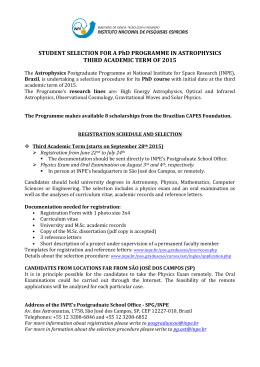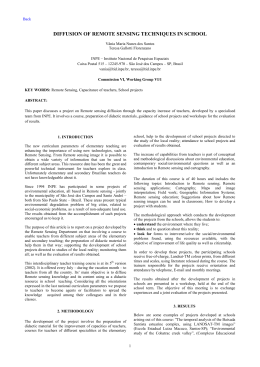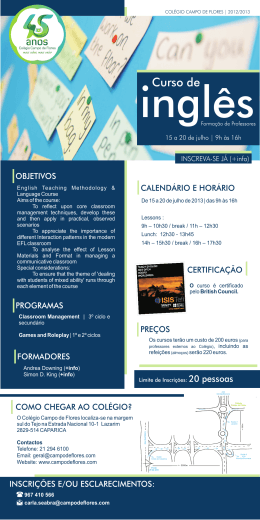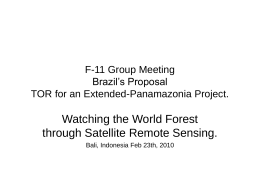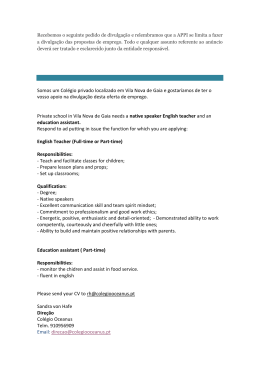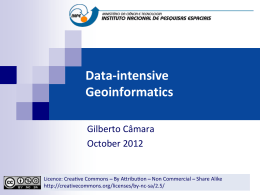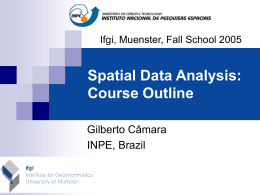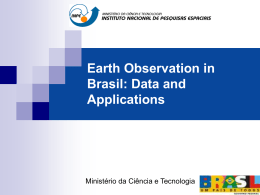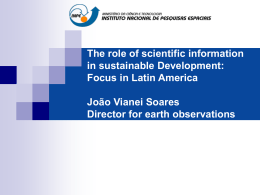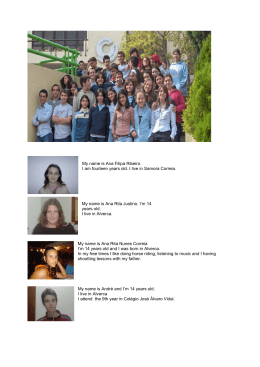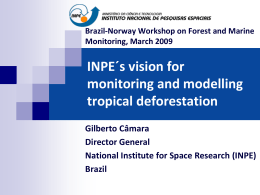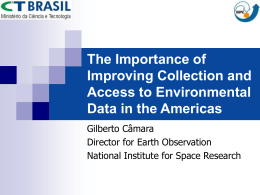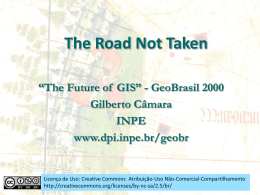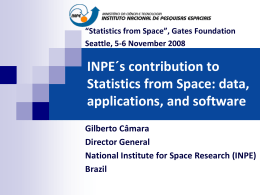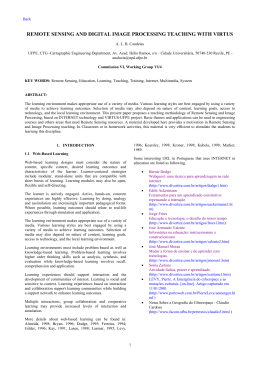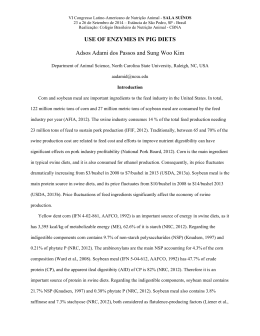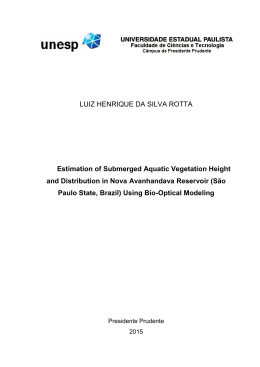Back Training New Talents in Space Science and Technology: INPE at School Tania Maria Sausen1, José Fernando Sanches da Silva2, Maria Ligia Moreira do Carmo2 Ministério da Ciência e Tecnologia, Instituto Nacional de Pesquisas Espaciais Coordenadoria de Ensino, Documentação e Programas Especiais1 Setor de Treinamento e Desenvolvimento2 Av. dos Astronautas 1758, P.O.Box. 515 CEP 12245-970 São José dos Campos, SP, Brasil. [email protected] Commission VI, Working Group VI/1 KEY WORDS: Remote Sensing, Education, Training New Talents ABSTRACT: The science and technology are remarked by its continuous evolution, renovation and improvement, which contribute for the progress. They depend on talented and dedicated professionals, able to make new discoveries and to change them in benefit to the human kind, in order to mitigate disaster and tragedies, to control the hunger and help men to go beyond their limits, going to the outer space. The progress of science and technology depend on somehow of the qualification of new talents. It is one of the most important way to guarantee their continuity and to have it as one of the most important benefit gotten by the mankind. The main objective of this project is to disseminate to the student community the space activities developed by INPE and PNAE in order to encourage the training of new talents in the space science and technology. INPE has an agreement with 22 private schools, in order to develop educational activities February INPE has held a one and half day seminar for the schools teacher where the following topics were presented: 1. OBJECTIVES The main objective of this project is to disseminate to the student community the space activities developed by INPE and PNAE in order to encourage the training of new talents in the space science and technology. • • • • 1.1 The Specific Objectives • • • • • • To arouse new talents in space science and technology in the grammar and high school student community; • To disseminate the space activities developed by INPE and PNAE; • To disseminate the spin off generated by the space activities developed by INPE and PNAE. The China-Brazil Earth Resource Satellite-CBERS; Remote sensing applied to natural resources; The satellite meteorology and its applications; The Data Collecting Satellite-SCD and its applications; Lightning: basic concepts and how to prevent them; The Test and Integration Laboratory-LIT in INPE; The International Space Station-ISS; The Space activities in classroom; How to prepare a project. After the seminar the schools had to choose one of these topics to develop in classroom during the 2002 first semester (March to June). The following topics were selected by the schools: 1.2 The goals • To train school teachers in order to be able to develop class activities about space science and technology; • To train the students in order to develop class activities concerning space science and technology; • To encourage through class activities, the students that are interested in science and technology to choose a future career related to space science; • To disseminate together with the teachers and the students to the community the spin off generated by space activities. • This Project was designed to geography, science, history, mathematic, physic and arts grammar and high school teachers. • • • • • • • 2. PROJECT DEVELOPMENT INPE has an agreement with 22 private schools, in order to develop educational activities. In November INPE did an announcement inviting the schools to take part in the project. • In December nine schools have accepted this invitation. In Colégio Saint Exupéry-Pequeno Príncipe: Data Collecting System; Colégio Teófilo Rezende: Remote sensing with emphasis in the São José dos Campos South Region; Colégio Mater Dei: Mater Dei and its surrounding area (remote sensing); Climate and Micro-climate in São José dos Campos region (meteorology) and The Remote Sensing and the Amazonia; Colégio Illuminati: The Brazilian participation in the ISS; Colégio Nossa Senhora Aparecida: The Remote Sensing applied to agriculture planning; Colégio Olavo Bilac: Remote Sensing applications; Colégio Joseense: The Data Collecting Satellite-SCD; Escola Cristã Batista Regular: SCD-1 –SCD-2 and the Data Collecting System; Escola Monteiro Lobato: The Data Collecting Platform-PCD. The 12 INPE researchers, one AEB researcher, one expert in education, 44 schools teachers and 588 students from grammar 1 The International Archives of the Photogrammetry, Remote Sensing and Spatial Information Sciences, Vol. XXXIV, Part 6, CVI (6-14 years old) to high school (15-17 years old) took part in the project, as follow: • • • • • • • • • Colégio Saint Exupéry-Pequeno Príncipe: 14 students; Colégio Teófilo Rezende: 180 students; Colégio Mater Dei: 70 students; Colégio Illuminati: 30 students; Colégio Nossa Senhora Aparecida: 10 students; Colégio Olavo Bilac: 40 students; Colégio Joseense: 200 students; Escola Cristã Batista Regular: 20 students; Escola Monteiro Lobato: 24 students. INPE researchers and staff that took part in the Project: • • • Dr. Bernardo Rudorff-Remote Sensing Division; Dr. Maurício Alves- Remote Sensing Division; Dr. Jorge Conrado Conforte- Remote Sensing Division;Dr. Marcelo Saba-Space Geophysic DivisionDr. Elbert E. N. Macau –Test and Integration Laboratory; • Dr. Petrônio Noronha de Souza –International Space Station Program • Dra. Elisabete Caria Moraes- Remote Sensing Division; • Dr. Mário Luiz Selingardi-Space Electronic Division • Ing. Luis Maurano-Digital Image Processing Division; • Ing. Fábio Loyolla-Weather and Forecast Climate Center • Ing. Sérgio de Paula Pereira-Environmental Satellite Division • Ing. Paulo César Gurgel de Albuquerque- Remote Sensing Division • Pedg. Maria Lígia Moreira do Carmo-Development and Traininig SectorMs. Miriam Vicente-Instituttional Relations Coordination External Colaborators: • • Fig.1 - Students preparing models for exhibition. Fig. 2 – Exhibition opening. Dr. Eduardo Barcelos-Brazilian Space Agency Socil.Vânia Maria Nunes Santos-Guarulhos Municipality In March 4th, schools started the project. Three project evaluation meetings were scheduled for April 16th, May 21st and June 17th. In order to help the teachers and students to develop the project, INPE has provided technical visits to its facilities, videos about the CBERS, SCD satellites and ISS and help the students to build a data collecting platform, sensor systems and the Brazilian ISS-Palete. Besides these, teachers training about environmental data, satellites image interpretation, satellite meteorology using an educational CD ROM developed by INPE, and helping with educational material, bibliography, web sites addresses, and asking to INPE researchers to give lectures and to assist the schools to develop the project. The schools that were involved with remote sensing were in contact with São José dos Campos municipality in order to get information about urban planning for their activities in the project. Fig. 3 - Model on Remote Sensing Application developed by students. 3. THE SCIENCE EXHIBITION In August the schools have presented the project results through a report and science exhibition in INPE Campus. In this exposition some schools presented satellite models, maps about natural resources studies, CD ROM, WEB pages, theater plays, dances, organized and develop by the students. This exposition was open to INPE and São José dos Campos Community. 2 The International Archives of the Photogrammetry, Remote Sensing and Spatial Information Sciences, Vol. XXXIV, Part 6, CVI Fig. 4 - Model on Remote Sensing Application developed by students of Colegio Nossa Senhora Aparecida. Fig. 7 – Scene perfomed by students on Remote Sensing and the countryside inhabitant. Fig.5 – Remote Sensing Project in the South Area of São José dos Campos developed by students of Colégio Mater Dei. Fig. 6 – Model on the SCD and Remote Sensing Satellite developed by students of Colegio Joseense. 3
Download
